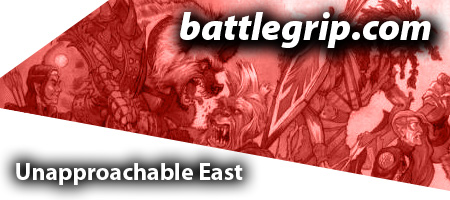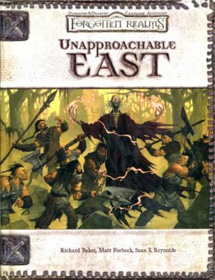Reading – Unapproachable East

NOTE: This is an older review that I am posting here in an attempt to collect my work from the past decade+ in one location.
This release for the Forgotten Realms (Amazon.com search*) clocks in as a 192-page hardcover packed with the glorious full-color artwork and graphic design you expect from a Forgotten Realms book. There’s something about the art direction for the line that has truly impressed me and each release only strengthens my belief that not only are the Wizards of the Coast art directors doing great work but Raven Mimura is growing as an artist. Raven’s work, again, stands out and speaks to me, inspires me. He’s really matured as an artist and I hope he’ll soon start doing covers for Wizards and not just interiors. And it’s important I mention Matt Wilson’s cover. The Realms books, with wrap-around covers, have so far all had beautiful covers and this one may be my favorite of the covers released so far.

This book follows the format of other recent Forgotten Realms books but bears a closer resemblance to Lords of Darkness than it does the Silver Marches. By which I mean there is a healthy chunk of crunchy rules content in addition to the background and setting information. I suspect this direction will continue with the books in the line and the bulk of new setting material for the Realms will find release as novels. This is a good thing for D&D players who do not use the Realms as their campaign setting. Now every new Realms book is another box of goodies to drop right in the current campaign and not just a source of knowledge of the Realms.
Unapproachable East*, in taking this approach, packs the first 81 pages of the book with new races, prestige classes, feats, spells and information on magic, magic items, and monsters. Taking a closer look at this information we see that it’s a total of six chapters of the book, which I shall now give overviews of.
Chapter One: Races of the East
Coming so close on the heels of Races of Faerun I thought I’d take a minute to compare the information in the two books. A quick check shows that the races herein are not just reprints from that book but are new races. The races are star elves, gnolls, hagspawn, spirit folk, taers, and volodnis. The level adjustments on these new races range from none to +2 so all are relatively low-level and could be used in most new campaigns. And all of them are illustrated.
Chapter Two: Prestige Classes
Is anyone shocked that the book contains prestige classes? From the Aglarondan Griffonrider (complete with griffon) to Thayan Slaver, all of these are deeply immersed in Realmslore. This does make using them in other campaigns a little more difficult but is there ever a campaign world that doesn’t have a place for “corrupt priests who revel in decay†as the Blightlord does? With class features like:
Blightblood: Immune to all diseases, including magical, and not attacked by “Blightspawned†creatures.
Blight Tough: Once per day make a touch attack and inflict a supernatural disease on an opponent.
There are twelve prestige classes in this chapter, all imaginative and a great source for NPCs and adventures.

Chapter Three: Regions and Feats
This chapter includes seven new regions (first introduced in the Forgotten Realms Campaign Setting book) and 18 new feats. While I did not run a comparison of the feats with other books the first page does state that the resources used in this book were several newer 3e books that I suspect were the source for some of these new feats. The fact that the back cover of the book does not specify “18 New Feats†makes me think I’m probably right. The new feats are: Battle Jump, Craft Contingent Spell, Draw from the Land, Ettercap Berserker, Explosive Spell, Extended Rage, Fortify Spell, Great Stag Berserker, Ice Troll Berserker, Improved Grapple, Long Reach, Owlbear Berserker, Rashemi Elemental Summoning, Snow Tiger Berserker, Transdimensional Spell, Vremyonni Training, Wolf Berserker, and Woodwise.
Chapter Four: Magic & Spells
Circle Magic, Contingent Spells, Place Magic, Rune Magic, and Shadow Weave are all “secrets of the east†and are touched on here. Page 59 of the Forgotten Realms Campaign Setting has the actual rules for circle magic and rune magic can also be found in the core Realms book. In fact, none of these “secrets of the east†seem all that new but I could be wrong.
The 21 new spells include decastave (a magical quarterstaff is conjured into existence) and improved mage armor (which is what it sounds like). Necromancer characters (perhaps created using Secret College of Necromancy) will want Sinsabur’s baleful bolt. This 4th level Sor/Wix spell fires a negative energy bolt that inflicts temporary Strength and Constitution damage. Soul scour, a 5th level cleric spell, corrupts the target’s soul, inflicting Charisma and Wisdom damage.

Chapter Five: Magic Items
This short (5-page) chapter includes nothing overly remarkable but DMs confronted with a shortage of treasures should find something of use here. New magic weapon special abilities can, of course, be used to create several more magic weapons than are featured in this chapter. These new special abilities are berserker, diseased (perfect for the Blightlord prestige class), dismisser (sends extraplanar creatures back to their plane of origin), valorous, and vampiric.
Bluewood, a new special material, is also introduced in this chapter. Bluewood is used in the construction of weapons and armor and gives the item the same hardness as an equivalent item made of metal but at half the weight.
Chapter Six: Monsters
Almost twenty monsters fill the 21-pages of this chapter. A few that stand out for me are:
Blightspawned: This template transforms creatures into decaying monstrosities with the ability to spread disease, and create other spawn. The illustration, by Sam Wood, depicts a blightspawned treant.
Nilshai: Alien sorcerers from the same plane as the ethereal filchers and ethereal marauders, these creatures have some abilities in common with those already-seen monsters and a host of new abilities. And they look really weird which is always a plus.
The remainder of the book details five lands of the Realms and a host of smaller “border†areas. Any of these can be imported into a campaign world if you’re not using the Realms. The first section, chapter seven, includes encounter tables and a section on organizations that operate in the area (including the Red Wizards). DMs intent on running campaigns set in this area should have everything they need to get started but the Lords of Darkness will prove most invaluable if the campaign gravitates to Thay (which is very likely if the player characters are already in the area).
If you’re a Forgotten Realms DM or player chances are you’ve already bought this book. If you typically pass on Realms books but play D&D (or any other D20 fantasy game) you may want to at least flip through the book the next time you visit a game store. You may just be surprised by some of the content within the covers.
Related articles
- Forgotten Realms Issue 19-Picking Up The Pieces from A Hero Twice A Month (aherotwiceamonth.com)
- The Fantasy Author’s Handbook Interview: Erin M. Evans (fantasyhandbook.wordpress.com)
- Play Unplugged Review – Ed Greenwood Presents Elminster’s Forgotten Realms (tabletopgamingnews.com)
